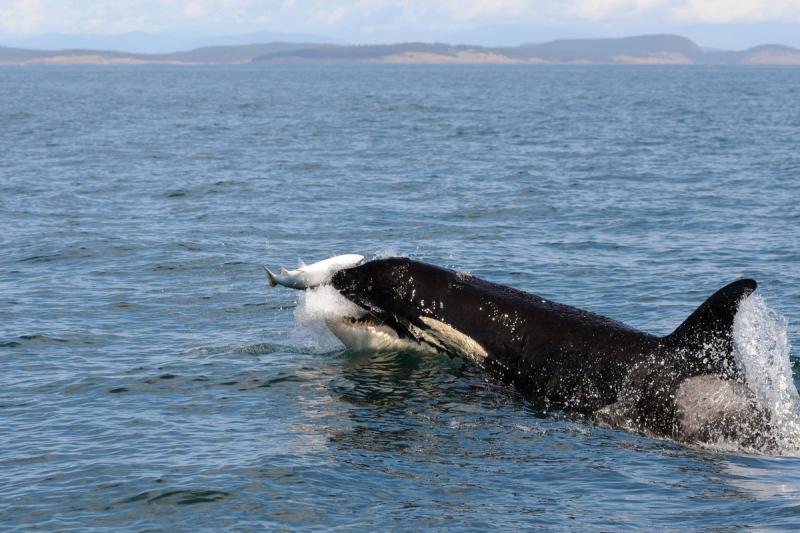Alright, stop the presses, folks. What is a 5-year review? What’s a distinct population segment? How and why are the beloved Southern Resident killer whales (SRKWs) still in danger of becoming extinct? Let’s break this down.
What Does This All Mean?
First, let’s explore the factors we consider for a species to be placed on the Endangered Species list:
- Present or threatened destruction, modification, or curtailment of its habitat or range
- Over-utilization of the species for commercial, recreational, scientific, or educational purposes
- Disease or predation
- Inadequacy of existing regulatory mechanisms
- Other natural or human-caused factors affecting its continued existence
SRKW were listed as endangered in 2005. The main threats being prey availability, pollution and contaminants, effects from vessels and sound, as well as small population size and vulnerability to oil spills. The Endangered Species Act requires a review of species listed under the Act every 5 years. Why? This ensures that the listed species retain an appropriate level of protection under federal law.
The SRKW are also what is called a “distinct population segment” of a tentative subspecies of North Pacific resident killer whales. Killer whales are found in every ocean and are all still known by the same species name, Orcinus orca. The SRKW are “distinct” based on their genetics, geographic range, and behavioral and cultural diversity compared to other resident orca whales in the North Pacific. They are the only resident killer whales that use coastal waters as far south as California. While many other orcas are doing well, the Southern Residents are not.
What Does the 5-year Review Involve?
We asked this question of Meg Wallen, a marine mammal specialist at NOAA Fisheries West Coast Region. She pulls together data and research to assess our progress in SRKW recovery. Meg looks for ways to connect the latest research with management actions to protect the whales.
"This review tells a comprehensive story of the research and recovery actions that have taken place in the last 5 years,” she says. This includes scientists from the Northwest Fisheries Science Center tracking whales on the water, for example. They put down sonobuoys to listen to the orca vocalizations, collect fecal samples, and take samples of leftover orca prey to tell what exactly they are eating.
Scientists like Marla Holt, a research wildlife biologist from the Northwest Fisheries Science Center, also observe how vessel and boating activity affect the orcas. When boats (even kayaks!) ventured near the whales, the researchers noticed the whales started spending more time traveling and less time foraging for food. Whale watchers and photographers love to see this traveling “surface behavior,”, but it means the whales are potentially being disturbed and not eating when boats are nearby.
Dr. Holt’s recent study found orcas descended more slowly, and took longer dives to capture prey, when nearby boats had navigational sonar switched on. “That suggests that it may prolong their effort to dive in search of prey, which like all marine mammals they have to do on a breath hold—so they can stay underwater only so long,” she says.
So Why Are the Southern Resident Killer Whales Still Endangered?
Even after these last 5 years of ongoing dedicated research, it’s still unclear if one single threat is most impeding the whales’ recovery. Is it scarcity of prey? Contaminants in the water from pollution? Disturbance from vessels and other sounds? Or is there a new health threat we have not yet uncovered? Unfortunately, there is no silver bullet. The answer is likely a combination of multiple factors that compound each other.
One reason why these whales are considered distinct is because they may be the only population with unique knowledge of some Chinook salmon runs. And guess what? Some Chinook salmon are also listed as endangered under the Endangered Species Act. While their food source may evolve over time, it’s a bit difficult to ask these orcas to just eat something else instead of endangered salmon.
The completed 5-year review did not offer positive news about the SRKW population, which now totals 73 individuals. We have continued to implement protections along with many partners. Our Species in the Spotlight plan recommends four priority actions to promote recovery. Accomplishments on those fronts include:
- Research has further revealed the impacts of vessel traffic on the whales and their feeding behavior, informing actions to reduce those impacts
- Increased hatchery production of juvenile Chinook salmon to boost the prey base for the whales as the fish grow into adults
- Expanded designated critical habitat for the whales to more fully encompass their range extending south into Northern California
- Amended the West Coast fisheries management plan for salmon to leave more salmon for the endangered whales in low-return years
- Raise awareness about the recovery needs of SRKW through a new school curriculum that highlights activities by many partners
The 5-year review is more than just a requirement laid out by a federal law. It is a testament to dedicated individuals, including NOAA Fisheries scientists to policy managers, to our federal, state, and international partners. They all continue to work together to understand what the next steps should be to recover the population to stable levels It will truly take all of us working together to protect and recover the Southern Resident killer whales as a vital part of our marine ecosystem.





